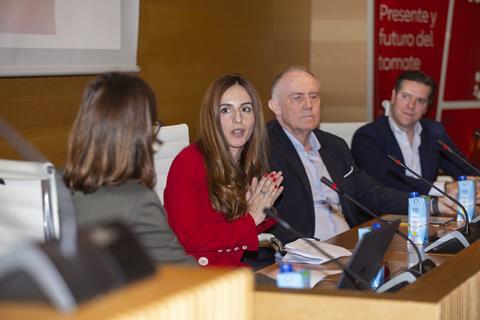Rijk Zwaan’s new congress Tomeet discusses the challenges and opportunities facing the sector
Leading players in the Spanish tomato business met in Almería last week to discuss the current and future challenges facing the sector at Rijk Zwaan’s first-ever Tomeet Congress.

Once the dominant player in Europe’s winter tomato market, Spain has borne the brunt of an influx of cheaper Moroccan tomatoes in recent years that have gradually whittled away its market share. At the same time, the impact of climate change, rising production costs and an increasingly punitive European legislative environment have created a grim commercial landscape for tomato producers in the Iberian Peninsula.
Luis Fernández of Coexphal highlighted Spain’s loss of competitiveness against third country supplier like Morocco where costs – particularly labour costs – are much lower. “This means that we have to work more efficiently, with the help of new technologies, and that we have to differentiate ourselves from our competitors,” he said.
David Uclés of Cajamar agreed that producers faced growing insecurity and uncertainty in the short-term, but painted a picture of a more positive future, in which lower interest rates will fuel more investments in technological improvements; the move to a plant-based diet would boost demand and imports from third countries would be forced to comply with EU regulations.
The programme then moved on to the subject of sustainability. Ana Hernández, director of R&D&i and Environment at Grupo Paloma, gave an overview of how the company is adapting its processes to become more sustainable and meet the challenges of climate change. These include opting for biological controls and hydroponic cultivation, optimising water usage and reducing CO2 emissions.
There then followed the first of two round table discussions featuring José María Naranjo, head of the Tomato Project at Carrefour Spain; Antonio Algarra Ibáñez of Grupo Agroponiente, and Pedro Ruiz García, president of Cooperativa La Palma. All three producers agreed that adopting varieties with resistance to ToBRFV was a priority for the sector. The need for retailers and producers to work more closely together to address common challenges, such as educating consumers about the different strands of sustainability was also highlighted.
Maria José González of consumer research firm NiQ presented the results of a survey showing that German consumers prioritise appearance, taste and price when buying tomatoes, although they highly value proximity and local products.
Continuing with the opportunities and challenges of the future of tomato exports, Wouter de Ruiter of De Ruiter Interim & Consultancy, talked about the very different strategies of European retail chains and the need for suppliers to tailor their offer and service to each one.
The challenges that the sector must face to differentiate itself and lead winter supply were analysed in a second round table featuring Juan Jesús Lara of Casi; Mais Zakarne of SanLucar and Enrique de los Ríos of Unica Group. The relative merits of different marketing strategies were discussed – from SanLucar’s success in positioning its brand with European retailers to the creation of an Almerían of Spanish tomato brand.
All the speakers agreed that it was necessary to invest more in promotion and once again called for greater unity between the entire sector to be stronger in the market.
At the end of the congress, Rijk Zwaan presented some of the solutions it has developed to respond to the new challenges facing the sector, notably ToBRFV.



